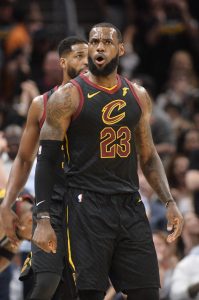The Lakers‘ 2018/19 salary cap outlook has been a subject of much speculation in the days, weeks, and months leading up to 2018’s free agent period, and it continues to be an area of particular interest for NBA fans now that the team has reached agreements to sign LeBron James, Kentavious Caldwell-Pope, Lance Stephenson, and JaVale McGee.
Do the Lakers still have cap room available? Can they keep Julius Randle and sign another free agent? If they let Randle walk, could they realistically make a play for a star free agent like DeMarcus Cousins?
Before Monday’s news cycle gains momentum, we want to take a quick look at those questions, breaking down what the Lakers can and can’t do with their remaining cap room.
First, let’s take a closer look at the commitments already on the Lakers’ books. Listed below are the contracts and contract agreements that will eat into the team’s cap room. Tentative salaries for free agents are listed in green, while cap holds are noted in blue. Stephenson’s and McGee’s deals aren’t listed because – based on reported terms – they can be completed using exceptions after the Lakers have used all their cap room.
Here’s the breakdown:
| Player | Salary |
|---|---|
| LeBron James | $35,654,150 |
| Luol Deng | $18,000,000 |
| Julius Randle | $12,447,727 |
| Kentavious Caldwell-Pope | $12,000,000 |
| Lonzo Ball | $7,461,960 |
| Brandon Ingram | $5,757,120 |
| Moritz Wagner | $1,762,080 * |
| Kyle Kuzma | $1,689,840 |
| Josh Hart | $1,655,160 |
| Ivica Zubac | $1,544,951 |
| Incomplete roster charge | $838,464 |
| Incomplete roster charge | $838,464 |
| Total | $99,649,916 |
* Note: There are ever-so-slightly conflicting figures out there for Wagner’s rookie scale amount. Our figure is based on RealGM’s rookie scale data.
With a salary cap of $101,869,000 for the 2018/19 season, the Lakers currently only have about $2.2MM in space. That’s not enough meaningful room to use on a veteran player, but it gives them some flexibility to sign their second-round picks (Isaac Bonga and Sviatoslav Mykhailiuk) or undrafted free agents to contracts with a longer term than two years, which could be useful.
It’s possible that the Lakers will simply use that leftover space on smaller deals, go over the cap to re-sign Randle using his Bird rights, and fill out their roster with the $4.449MM room exception (earmarked for Stephenson) and minimum-salary deals. Doing so would allow the club to maximize its flexibility for future seasons, depending on the terms of Randle’s new deal.
However, if the Lakers want to create space to make a run at another free agent, there are viable paths to doing so. Here are a few scenarios:
- Waiving and stretching Deng: $12.02MM in total cap room.
- Renouncing Randle: $13.83MM in total cap room.
- Trading Deng without taking back any salary: $19.38MM in total cap room.
- Waiving and stretching Deng and renouncing Randle: $23.63MM in total cap room.
- Trading Deng without taking back any salary and renouncing Randle: $30.99MM in cap room.
In other words, there are still ways for the Lakers to create significant cap space. However, trading Deng would likely involve attaching multiple young players and/or draft picks to him. Those are pieces the Lakers would prefer to keep or use in a deal for an impact player, so the club may hold off on such a move.
Meanwhile, there aren’t many free agents out there who are better bets than Randle, so the Lakers may prioritize working out a new deal with their own restricted free agent rather than making multiple roster moves to pursue an outside target.
Salary information from Basketball Insiders was used in the creation of this post. Photo courtesy of USA Today Sports Images.

